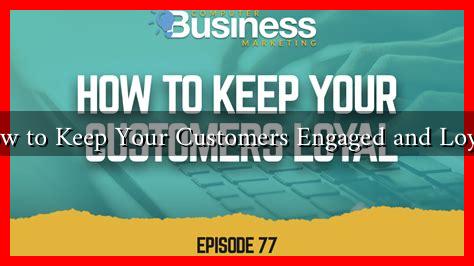-
Table of Contents
How to Keep Your Customers Engaged and Loyal
In today’s competitive marketplace, customer engagement and loyalty are more crucial than ever. With numerous options available, customers can easily switch brands if they feel neglected or undervalued. Therefore, businesses must adopt effective strategies to keep their customers engaged and loyal. This article explores various methods to achieve this goal, supported by examples, case studies, and statistics.
The Importance of Customer Engagement
Customer engagement refers to the emotional connection between a brand and its customers. Engaged customers are more likely to make repeat purchases, recommend the brand to others, and provide valuable feedback. According to a study by Gallup, companies with high customer engagement scores outperform their competitors by 147% in earnings per share.
Strategies to Enhance Customer Engagement
Here are some effective strategies to keep your customers engaged:
- Personalization: Tailoring your marketing efforts to meet individual customer preferences can significantly enhance engagement. For instance, Netflix uses algorithms to recommend shows based on viewing history, keeping users engaged and satisfied.
- Quality Content: Providing valuable content that resonates with your audience can foster loyalty. Brands like HubSpot excel in this area by offering free resources, webinars, and blogs that educate their customers.
- Social Media Interaction: Engaging with customers on social media platforms can create a sense of community. Brands like Wendy’s have successfully used humor and wit on Twitter to engage their audience, resulting in increased brand loyalty.
- Customer Feedback: Actively seeking and implementing customer feedback shows that you value their opinions. Starbucks, for example, uses its My Starbucks Idea platform to gather customer suggestions, leading to innovative product offerings.
- Loyalty Programs: Implementing a rewards program can incentivize repeat purchases. Sephora’s Beauty Insider program is a prime example, offering points for purchases that can be redeemed for exclusive products and experiences.
Case Studies of Successful Customer Engagement
Several companies have successfully implemented customer engagement strategies that resulted in increased loyalty:
- Amazon: Amazon’s recommendation engine is a powerful tool that personalizes the shopping experience. By analyzing customer behavior, Amazon suggests products that customers are likely to purchase, leading to higher conversion rates.
- Coca-Cola: Coca-Cola’s “Share a Coke” campaign encouraged customers to find bottles with their names on them. This personalized approach not only increased sales but also created a buzz on social media, enhancing customer engagement.
- Zappos: Known for its exceptional customer service, Zappos empowers its employees to go above and beyond for customers. This commitment to service has resulted in a loyal customer base and a strong brand reputation.
Utilizing Technology for Engagement
Incorporating technology into your engagement strategy can streamline processes and enhance customer experiences. Here are some technological tools to consider:
- Email Marketing Automation: Tools like Mailchimp allow businesses to send personalized emails based on customer behavior, ensuring timely and relevant communication.
- Chatbots: Implementing AI-driven chatbots on your website can provide instant support to customers, improving their experience and engagement.
- Customer Relationship Management (CRM) Systems: CRM tools like Salesforce help businesses track customer interactions and preferences, enabling personalized marketing efforts.
Measuring Customer Engagement and Loyalty
To ensure your strategies are effective, it’s essential to measure customer engagement and loyalty. Key performance indicators (KPIs) to consider include:
- Customer Lifetime Value (CLV)
- Net Promoter Score (NPS)
- Customer Retention Rate
- Engagement Rate on Social Media
Regularly analyzing these metrics can help you refine your strategies and improve customer satisfaction.
Conclusion
Keeping customers engaged and loyal is an ongoing process that requires a combination of personalization, quality content, and effective communication. By implementing the strategies discussed in this article, businesses can foster strong relationships with their customers, leading to increased loyalty and long-term success. Remember, engaged customers are not just buyers; they are advocates who can help grow your brand through word-of-mouth and social sharing. For more insights on customer engagement, consider exploring resources from HubSpot and Gallup.

